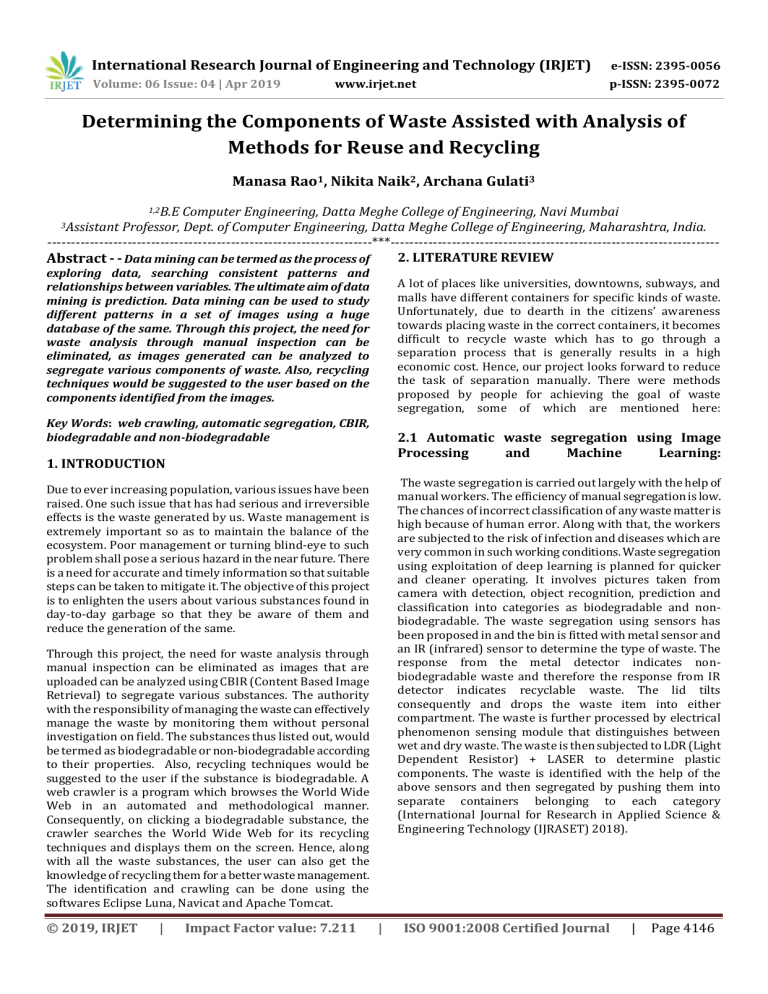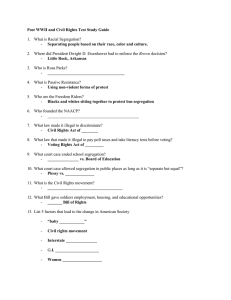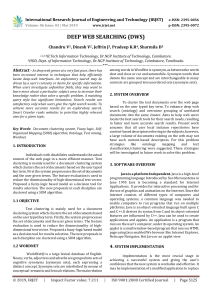
International Research Journal of Engineering and Technology (IRJET)
e-ISSN: 2395-0056
Volume: 06 Issue: 04 | Apr 2019
p-ISSN: 2395-0072
www.irjet.net
Determining the Components of Waste Assisted with Analysis of
Methods for Reuse and Recycling
Manasa Rao1, Nikita Naik2, Archana Gulati3
1,2B.E Computer Engineering, Datta Meghe College of Engineering, Navi Mumbai
Professor, Dept. of Computer Engineering, Datta Meghe College of Engineering, Maharashtra, India.
---------------------------------------------------------------------***---------------------------------------------------------------------2. LITERATURE REVIEW
Abstract - - Data mining can be termed as the process of
3Assistant
exploring data, searching consistent patterns and
relationships between variables. The ultimate aim of data
mining is prediction. Data mining can be used to study
different patterns in a set of images using a huge
database of the same. Through this project, the need for
waste analysis through manual inspection can be
eliminated, as images generated can be analyzed to
segregate various components of waste. Also, recycling
techniques would be suggested to the user based on the
components identified from the images.
A lot of places like universities, downtowns, subways, and
malls have different containers for specific kinds of waste.
Unfortunately, due to dearth in the citizens’ awareness
towards placing waste in the correct containers, it becomes
difficult to recycle waste which has to go through a
separation process that is generally results in a high
economic cost. Hence, our project looks forward to reduce
the task of separation manually. There were methods
proposed by people for achieving the goal of waste
segregation, some of which are mentioned here:
Key Words: web crawling, automatic segregation, CBIR,
biodegradable and non-biodegradable
2.1 Automatic waste segregation using Image
Processing
and
Machine
Learning:
1. INTRODUCTION
The waste segregation is carried out largely with the help of
manual workers. The efficiency of manual segregation is low.
The chances of incorrect classification of any waste matter is
high because of human error. Along with that, the workers
are subjected to the risk of infection and diseases which are
very common in such working conditions. Waste segregation
using exploitation of deep learning is planned for quicker
and cleaner operating. It involves pictures taken from
camera with detection, object recognition, prediction and
classification into categories as biodegradable and nonbiodegradable. The waste segregation using sensors has
been proposed in and the bin is fitted with metal sensor and
an IR (infrared) sensor to determine the type of waste. The
response from the metal detector indicates nonbiodegradable waste and therefore the response from IR
detector indicates recyclable waste. The lid tilts
consequently and drops the waste item into either
compartment. The waste is further processed by electrical
phenomenon sensing module that distinguishes between
wet and dry waste. The waste is then subjected to LDR (Light
Dependent Resistor) + LASER to determine plastic
components. The waste is identified with the help of the
above sensors and then segregated by pushing them into
separate containers belonging to each category
(International Journal for Research in Applied Science &
Engineering Technology (IJRASET) 2018).
Due to ever increasing population, various issues have been
raised. One such issue that has had serious and irreversible
effects is the waste generated by us. Waste management is
extremely important so as to maintain the balance of the
ecosystem. Poor management or turning blind-eye to such
problem shall pose a serious hazard in the near future. There
is a need for accurate and timely information so that suitable
steps can be taken to mitigate it. The objective of this project
is to enlighten the users about various substances found in
day-to-day garbage so that they be aware of them and
reduce the generation of the same.
Through this project, the need for waste analysis through
manual inspection can be eliminated as images that are
uploaded can be analyzed using CBIR (Content Based Image
Retrieval) to segregate various substances. The authority
with the responsibility of managing the waste can effectively
manage the waste by monitoring them without personal
investigation on field. The substances thus listed out, would
be termed as biodegradable or non-biodegradable according
to their properties. Also, recycling techniques would be
suggested to the user if the substance is biodegradable. A
web crawler is a program which browses the World Wide
Web in an automated and methodological manner.
Consequently, on clicking a biodegradable substance, the
crawler searches the World Wide Web for its recycling
techniques and displays them on the screen. Hence, along
with all the waste substances, the user can also get the
knowledge of recycling them for a better waste management.
The identification and crawling can be done using the
softwares Eclipse Luna, Navicat and Apache Tomcat.
© 2019, IRJET
|
Impact Factor value: 7.211
|
ISO 9001:2008 Certified Journal
|
Page 4146
International Research Journal of Engineering and Technology (IRJET)
e-ISSN: 2395-0056
Volume: 06 Issue: 04 | Apr 2019
p-ISSN: 2395-0072
www.irjet.net
2.2 Automatic waste segregator and monitoring
using ultrasonic sensors:
is used for creating a database of substances which are
biodegradable and non-biodegradable separately.
The design of Automatic waste segregator aims at sorting the
waste into three main categories namely; metallic, organic
and plastic, thereby making the waste management more
effective. Ultrasonic sensors are used for watching waste
segregation process. The sensors would be placed in all the
bins.
3.3
Navicat for MySQL is the ideal solution for MySQl
administration and development of databases. It provides an
intuitive and powerful graphical user interface for database
management, development and maintenance. It connects to
multiple databases on a single GUI. It helps us create, edit
and run SQL statements/queries without having to worry
about syntax and proper usage of commands.
When the rubbish reaches the amount of the detector, then
the indication will be given to a microcontroller.
The microcontroller will give indication to the driver of
garbage collection truck by sending SMS using GSM
technology (Journal of Microcontroller Engineering and
Applications 2016).
3.4
3.5
3. DESCRIPTION OF COMPONENTS
ECLIPSE LUNA
3.6
A widely used, user friendly, open source Relational
database Management system (RDBMS) that uses Structured
Query Language (SQL) for accessing and managing content
in a database. It allows multiple users to create and manage
multiple databases in a time-shared manner. Also, the
software is available for free. Hence, for our project, MYSQL
|
Impact Factor value: 7.211
APACHE TOMCAT
Basically, after writing the java code, we need to deploy the
Java servlets and JSPs (Java Server Pages). Hence, Apache is
an HTTP (hypertext transfer protocol) Server and Tomcat is
a web server (which can handle HTTP requests/responses)
and web container in one. To store, process and deliver web
pages to clients, a web server is employed. HTTP handles the
communication between the client and the server.
MYSQL
© 2019, IRJET
Web Crawling
A crawler is a program designed to visit numerous Web sites
and read their pages and other information in order to
create entries for a search engine index. All major search
engines on the Web have such a program, which is also
known as a "spider" or a "bot." It browses the World Wide
Web in an automated manner. A search engine employs
special software robots, called spiders, to find information
on the hundreds of millions of web pages that exist, by
building lists of the words found on web sites. Web Crawling
is the process that includes the results compiled using the
list provided by these spiders.
Eclipse Luna supports Java 8 officially, that includes implicit
support for Java development tools, Plug-in Development
Tools, Object Teams, Eclipse Communication Framework,
Maven integration, Xtext, Xtend, Web Tools Platform and
Memory Analyzer. It is an essential tool for any Java
developer, which includes a Java IDE (Integrated
Development Environment), XML (eXtensible Markup
Language) editor and WindowBuilder. Eclipse is an
integrated development environment (IDE) for
programming in Java in the field of computer programming
and is the most widely used Java IDE throughout the
Industry. The environment can be customized not only by
using the base workspace, but also by an extensible plug-in
system. Java is used to design the front end of our
application.
3.2
CBIR
Content Based Image Recognition (CBIR) is the process using
which, one can search images which are similar to the
content of the query image based on color, texture, shape etc.
It uses color percentages, color layout, texture, shape,
location, and keywords for this purpose. First the images are
segmented on color plus texture, then user selects a region of
the query image and after that the system returns images
with similar regions. This method is also known as query by
image content (QBIC). ‘Content Based’ is the term used when
the search analyzes the content of the image rather than the
metadata i.e. keyword tags or descriptors associated with
the image.
Taking a glance into the history of separate waste
assortment and exercise, one will notice that, in time, many
solutions were used, however only an absence of resources
appeared did the government and local authorities take
action in order to establish rules for separate waste
collection. As we can see the usage of hardware concepts is
quite expensive for separating waste at a small scale. Hence,
we have come up with a software solution, making a webbased application wherein the application itself will identify
the components without any sensor or human assistance,
thus reducing cost and time.
3.1
NAVICAT
4. REQUIREMENT ANALYSIS
|
•
Apache Tomcat Server
•
MySQL 5.1
ISO 9001:2008 Certified Journal
|
Page 4147
International Research Journal of Engineering and Technology (IRJET)
e-ISSN: 2395-0056
Volume: 06 Issue: 04 | Apr 2019
p-ISSN: 2395-0072
www.irjet.net
6. PROPOSED METHODOLOGY
•
Navicat
•
Java jdk 1.6 or above
•
Computer
•
Basic Computer
capabilities.
•
Min Req:
with
computational
• Pentium Processor or above
• 2GB RAM
• 80GB Hard Disk
•
Front end design using following languages: JSP,
Servlet, HTML5, CSS, JQUERY, AJAX, Bootstrap
5. PROCEDURE
The process of segregation begins by first uploading the
image for which the segregation is to be done. The
application then checks this image with the dataset of
images already present in the database. The similar
substances are matched with and listed out accordingly. If
there are any new substances that are not present in the
database, the system displays checks for the shape, size and
color of the substance. As it is evident that there are a few
shortcomings in our system, but it can effectively work for
low scale garbage production such as the waste collected
from our homes or small offices on a day to day basis. There
is a lot of future scope for our system, which can be further
modified and deployed for segregation of large waste
collected in huge institutions and garbage dump areas.
© 2019, IRJET
|
Impact Factor value: 7.211
Our proposed system is designed in a way, wherein the user
has to first upload the image from his/her system (that is a
desktop, laptop, or a mobile phone). Now the system begins
the process of segregating the different components present
in that image and lists them out. Then they are classified into
their respective categories. These categories can be broadly
classified into ‘Recyclable’ and ‘Non-Recyclable’. Under
Recyclable waste, it describes the type of the material, viz:
Paper, Metal, etc. and under non-recyclable, there are
materials like plastic, nylon, etc. Once the system completes
the task of analyzing the image, it not only gives the
classification of the materials into their respective
categories, but also gives crawled results from the internet
for enlightening the user with the knowledge of how to
recycle the recyclable materials successfully. This is done by
hyperlinking the name of the category to which the material
belongs to. Hence, this way it becomes easier for the user to
get details about the type of materials accumulated in the
waste. Since this is a primitive version of the system, there
are various shortcomings in the overall system. As image
classification is a wide domain, all functionalities of the
system cannot be in this version. The future scope of this
project includes recognition of a wide range of materials and
classifying them successfully into its respective class.
|
ISO 9001:2008 Certified Journal
|
Page 4148
International Research Journal of Engineering and Technology (IRJET)
e-ISSN: 2395-0056
Volume: 06 Issue: 04 | Apr 2019
p-ISSN: 2395-0072
www.irjet.net
7. RESULT
8. Amrutha Chandramohan, et al. Automated Waste
Segregator. National Level Analog System Design Contest,
2013–2014; Conducted by Texas Instruments, India
In this work, we successfully develop a system that can help
in an automated waste segregation system by analyzing the
various substances from an uploaded image.
●
First, display the various components in the image
●
Second, segregate them as degradable and nondegradable and display them separately
●
Display the links for biodegradable substances
using crawling concept
●
Enable the user to segregate the waste without
human assistance
●
Give knowledge to the user about various recycling
techniques for the waste generated
9. Yamazaki S, Nakane GH, Tanaka A. Basic Analysis of a
Metal Detector. IEEE Instr Meas. Aug 2002; 51(4): 810–814p.
8. REFERENCES
Bajaj JS. Urban Solid Waste Management in India. New Delhi:
Planning Commission Government of India; 1995.
1.
Daniel Hoornweg, et al. What a Waste: A Global
Review of Solid Waste Management. Washington, DC: Urban
Development & Local Government Unit World Bank, No.15;
Mar 2012.
2. Shuchi Gupta, Krishna Mohan, Raj Kumar Prasad, et al.
Solid Waste Management in India: Options and
Opportunities. In Resource, Conservation and Opportunities.
Nov 1996; 24(2):137p.
3. Amrutha Chandramohan, Joyal Mendonca, Nikhil Ravi
Shankar,“Automated Waste Segregator”,India Educators'
Conference (TIIEC), 2014 Texas Instruments , IEEE,
5.1109/TIIEC.2014.009 . Keerthana B, Sonali M
Raghavendran, “Internet of Bins Trash Management in
India”, 2017 Second International Conference on Computing
and Communications Technologies (ICCCT’17), IEEE
10.1109/ICCCT2.2017.7972277.
4. Sakai S, Sawell SE, Chandler AJ. World Trends in Municipal
Solid Waste Management. Environmental Preservation
Centre, Kyoto University, Japan. 1996; 16: 341p.
5. Claudine Capel. Innovations in Waste. Waste Management
World. Mar 2010; 11(2).
6. Claudine Capel. Waste Sorting: A Look at the Separation
and Sorting Techniques in Today’s European Market. WasteManagement-World. Jul 2008; 9(4). Journal of
Microcontroller Engineering and Applications Volume 3,
Issue 2 ISSN: 2455-197X (online) JoMEA (2016) 1-7 © STM
Journals 2016. All Rights Reserved
7. Sathish M, et al. E-bin. Advance in Electronic and Electric
Engineering (AEEE). 2013;
© 2019, IRJET
|
Impact Factor value: 7.211
|
ISO 9001:2008 Certified Journal
|
Page 4149


